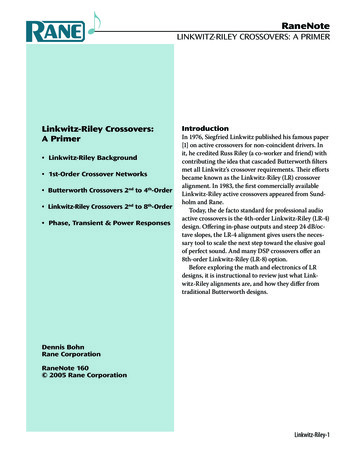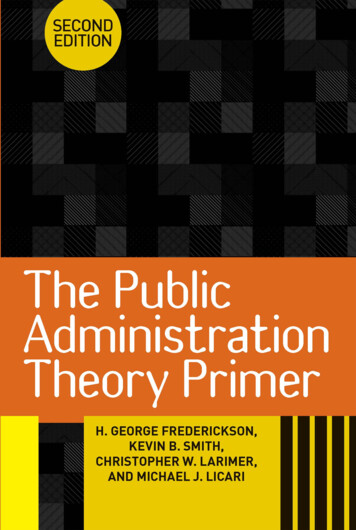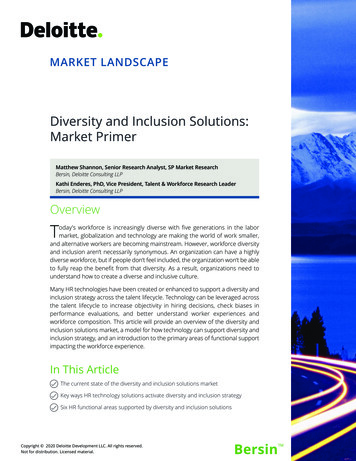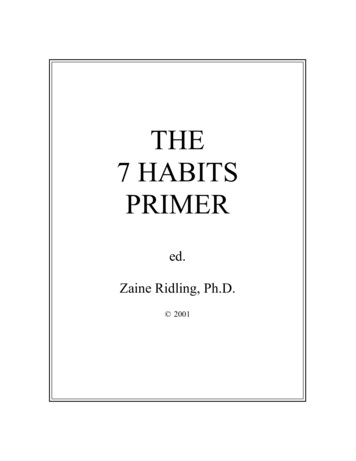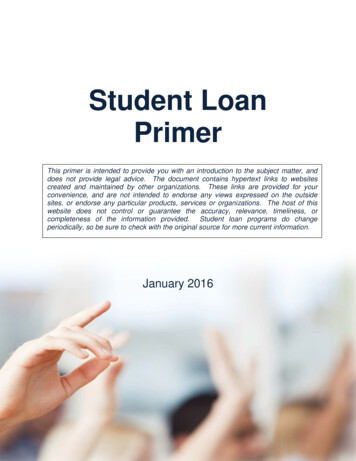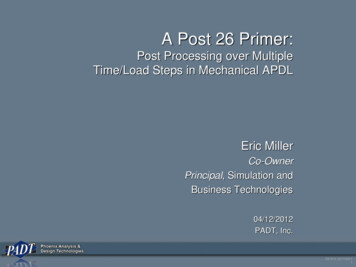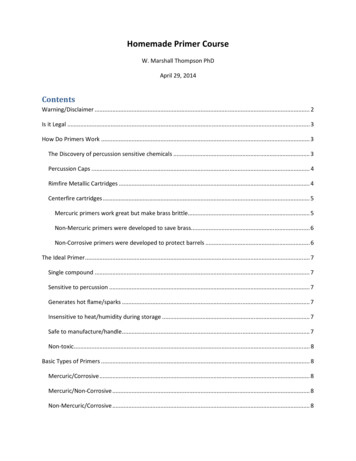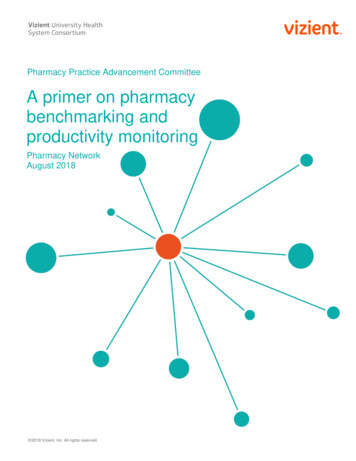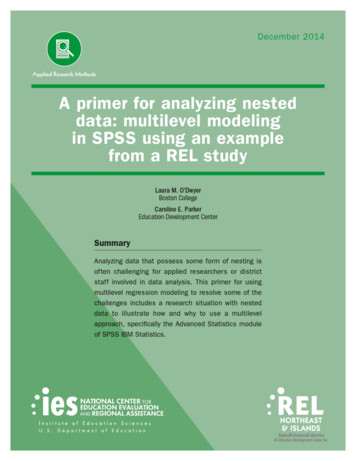
Transcription
REL 2015–046The National Center for Education Evaluation and Regional Assistance (NCEE) conductsunbiased large-scale evaluations of education programs and practices supported by federalfunds; provides research-based technical assistance to educators and policymakers; andsupports the synthesis and the widespread dissemination of the results of research andevaluation throughout the United States.December 2014This report was prepared for the Institute of Education Sciences (IES) under contractED-IES-12-C-0009 by Regional Educational Laboratory Northeast & Islands administeredby Education Development Center, Inc. (EDC). The content of the publication does notnecessarily reflect the views or policies of IES or the U.S. Department of Education nordoes mention of trade names, commercial products, or organizations imply endorsement bythe U.S. Government.This REL report is in the public domain. While permission to reprint this publication isnot necessary, it should be cited as:O’Dwyer, L. M., and Parker, C. E. (2014). A primer for analyzing nested data: multilevel mod eling in SPSS using an example from a REL study (REL 2015–046). Washington, DC: U.S.Department of Education, Institute of Education Sciences, National Center for Educa tion Evaluation and Regional Assistance, Regional Educational Laboratory Northeast &Islands. Retrieved from http://ies.ed.gov/ncee/edlabs.This report is available on the Regional Educational Laboratory website at http://ies.ed.gov/ncee/edlabs.
SummaryResearchers often study how students’ academic outcomes are associated with the charac teristics of their classrooms, schools, and districts. They also study subgroups of studentssuch as English language learner students and students in special education. However,district personnel may not be aware that commonly used analytic methods might giveinaccurate readings of the statistical significance of results when individual (student)data are nested within groups (classrooms, programs, schools) or when group-level dataare disaggregated to predict individual outcomes. In these cases, it may be necessary touse multilevel regression modeling (also known as hierarchical linear modeling or linearmixed modeling) to analyze data. This primer on conducting multilevel regression analy ses to address these issues using the Advanced Statistics module of SPSS IBM Statisticsshould be useful to applied researchers and district staff engaged in or in charge of dataanalysis.A recent study by Regional Educational Laboratory Northeast & Islands focusing on theachievement of a cohort of English language learner students (Parker, O’Dwyer, & Irwin,2014) asked which characteristics of students, English language learner programs, andschools were most closely related to the students’ English proficiency scores. Such researchis often addressed using a prediction modeling technique called ordinary least squares(OLS) regression. OLS regression is used to examine the strength and direction of the rela tionship between two variables in a statistical model while holding other variables con stant. It is used extensively as an exploratory, explanatory, and predictive tool. However, astandard OLS model may not be appropriate in situations where individuals are nested ingroups because nesting may lead to a statistical dependency among the observations in thesample.1Statistical dependencies can occur for multiple reasons, including situations in which indi viduals share the same educational context—where individuals are nested in classroomsor schools—and situations in which group-level characteristics are used to predict individ ual outcomes. An example of the first situation is English language learner students whoattend the same school. These students are likely to be more similar to each other than toindividuals in other schools (they are drawn from the same communities, use similar schoolresources, have the same teachers), and so statistical dependency may occur. The secondsituation occurs when the analysis aims to examine the relationships between group char acteristics and individual outcomes. Because each individual in a group is assigned thesame value for a group characteristic, a statistical dependency can occur.In the presence of statistical dependency and assuming that the model is correctly speci fied, standard OLS regression can produce unbiased estimates of the relationships betweenvariables (the regression coefficients). However, the standard errors associated with theregression coefficients may be biased, leading to incorrect conclusions about the statisticalsignificance of the observed relationships. One of the key assumptions of OLS models (andseveral other common analysis procedures) is that each individual provides a unique pieceof statistical information that is unrelated to the information provided by other individualsin the sample. Statistical dependency violates this assumption and can lead to downwardlybiased estimates of the standard errors associated with the regression coefficients and ulti mately to incorrect statistical conclusions.i
Multilevel regression modeling does not correct bias in the regression coefficient estimatescompared with an OLS model; however, it produces unbiased estimates of the standarderrors associated with the regression coefficients when the data are nested, and easilyallows group characteristics to be included in models of individual outcomes (Snijders& Bosker, 1999; Raudenbush & Bryk, 2001; Bickel, 2007, Gelman & Hill, 2007; Hox,2010). Although multilevel modeling is an advanced data analysis procedure that requiresspecialized software and data analysis skills, several readily available statistical packagesprovide the capability to conduct such analyses, including the Advanced Statistics moduleof SPSS IBM Statistics, used for the analysis in this primer.ii
ContentsSummaryiWhy this primer?1Challenges in using ordinary least squares regression analysis with nested dataStatistical significance tests evaluate the strength of relationshipsDanger of false-positive or false-negative errors344Analyzing nested data with multilevel modelingAccounting for statistical dependencyVariance and covariance can be partitioned into within-group and between-group componentsComparing the two statistical modelsSample size is important45567An illustration using English language learner student and school dataTwo-level model used to predict English proficiency scoresInterpreting the results of ordinary least squares and multilevel regression modelsImplications of statistical dependencyAppendix AStep by step procedure for using the Advanced Statistics module ofSPSS IBM ey terms2Table1Comparison of results for a multilevel model and an ordinary least squares modelpredicting English language learner students’ scores on a test of English proficiency8iii
Why this primer?A recent study by the Regional Educational Laboratory Northeast & Islands on theachievement of a cohort of English language learner students in a large school district inConnecticut asked which characteristics of students, English language learner programs,and schools were most closely related to the students’ English proficiency scores (Parkeret al., 2014).A common statistical method used to address this type of question is ordinary least squares(OLS) regression analysis. OLS regression, which can examine the strength and directionof the relationship between two variables while holding other variables constant, is usedextensively as an exploratory, explanatory, and prediction tool. However, a standard OLSmodel may produce misleading results about the statistical significance of a relationshipwhen it is used to analyze data collected from students in classrooms and schools becauseof this “nesting” of data—students nested within classrooms.A key assumption of OLS models (and several other common analysis procedures) is thateach individual in the sample provides a unique piece of statistical information unrelatedto the information provided by other individuals in the sample. Because students whoattend the same school are likely to be more similar to each other than they are to indi viduals in other schools (they are drawn from the same communities, use similar schoolresources, have the same teachers), meeting this assumption can be difficult. A standardOLS regression can produce statistically unbiased estimates of the relationships amongvariables (regression coefficients); however, the nesting of students in schools leads to cor related observations (a dependency among the data) and the possibility of downwardlybiased estimates of the standard errors associated with the regression coefficients. If adjust ments are not made to the OLS model to account for the statistical dependency introducedby nesting, analysts can make substantive errors in interpreting the statistical significanceof relationships (Raudenbush & Bryk, 2001).2Education researchers also frequently examine how group or organizational characteristics,such as the characteristics of schools, are associated with individual outcomes. Each indi vidual in a group is assigned the same value for the group characteristic. However, a groupcharacteristic that is disaggregated to the individual level cannot explain individual differ ences within a group. For example, the percentage of students who receive free or reducedprice lunches at a school cannot explain student-to-student differences in test performancewithin a school. A standard OLS model that includes a disaggregated variable will use theindividual-level sample size, which is inaccurate for a variable measured at the group level,for determining statistical significance. This practice can also lead to incorrect conclusionsabout the significance of the relationships under investigation.The REL Northeast & Islands study of English language learner students examined thecharacteristics of students, English language learner programs, and schools most closelyrelated to their English proficiency scores (Parker et al., 2014). The researchers had to con sider the possibility of a statistical dependency among the English language learner stu dents who attended the same school while also including school characteristics in modelsfor predicting individual student outcomes.1A standardordinary leastsquares regressioncan producestatisticallyunbiased estimatesof the relationshipsamong variables;however, thenesting of studentsin schools leadsto statisticaldependency andthe possibility ofdownwardly biasedestimates of thestandard errors
Over the past two decades, multilevel modeling (also known as hierarchical linear mod eling or linear mixed modeling)3 has become a popular way to analyze data with statis tical dependency (see box 1 for definitions of key terms). Multilevel regression modelingdoes not correct bias in the regression coefficient estimates compared with an OLS model;however, it produces unbiased estimates of the standard errors associated with the regres sion coefficients when the data are nested and easily allows group characteristics to beincluded in models of individual outcomes (Snijders & Bosker, 1999; Raudenbush & Bryk,2001; Bickel, 2007, Gelman & Hill, 2007; Hox, 2010).4 Although multilevel modeling is anadvanced data analysis procedure that may require specialized software and data analysisskills, several readily available statistical packages make it more accessible. For example,Stata and SAS allow analyses that account for statistical dependency in the estimationof standard errors. Likewise, the Advanced Statistics module of SPSS IBM Statistics usesmultilevel modeling to analyze data with statistical dependency.This primer provides guidance to applied researchers and district staff engaged in or incharge of analyzing data with nested components and who have access to the AdvancedStatistics module of SPSS IBM Statistics.5 Although this discussion focuses on OLS regres sion analysis, the effects of nesting are relevant for other commonly used inferential testsBox 1. Key termsIntercept-only model: A type of multilevel regression model in which only the intercept isallowed to vary from group to group.Intraclass correlation coefficient: The proportion of variance in the dependent variable that liesbetween groups. The intraclass correlation coefficient ranges from 0 to 1 and is used to estimatethe degree of statistical dependency in the data. If there is no statistical dependency, all of thevariance would be expected to lie among individuals, and the intraclass correlation coefficientwould be zero or close to zero. Conversely, with highly dependent data, the largest proportion ofvariance would lie among groups, and so the intraclass correlation coefficient would be closer to 1.Multilevel regression modeling: A set of statistical models that accounts for the statisticaldependency that may result from nested data. When the assumptions of the models are met,they provide unbiased estimates of the standard errors associated with regression coefficientsand allow group characteristics to be included in statistical models of individual outcomes(Snijders & Bosker, 1999; Raudenbush & Bryk, 2001; Bickel, 2007, Gelman & Hill, 2007; Hox,2010). The approach is also known as hierarchical linear modeling or linear mixed modeling.Nested data: When data are collected from multiple individuals in a group, the individual dataare considered nested within that group.Ordinary least squares (OLS) regression: A statistical model used to describe the relationshipbetween an array of variables (independent variables) and a dependent variable. OLS modelsassume that the relationship between the dependent and independent variables is linear, thatthe prediction errors are normally distributed and equally variable across the range of scores,and that the prediction errors for individuals are uncorrelated with each other.Statistical dependence: When the prediction error for the ith individual is correlated with theprediction error for the ith 1 individual. It occurs when individuals are nested in groups or whengroup characteristics are disaggregated to the individual level and leads to biased estimatesof the standard errors associated with the regression coefficients in an OLS model.2Multilevelregressionmodeling producesunbiased estimatesof the standarderrors associatedwith the regressioncoefficients whenthe data arenested and easilyallows groupcharacteristicsto be includedin models ofindividualoutcomes
such as t-tests, analysis of variance, and correlation. While this primer considers data withtwo levels, such as individuals nested within groups (students nested within schools), mul tiple levels of nesting, such as students within classrooms, classrooms within schools, orschools within districts, are also common.6The following sections describe the challenges to OLS regression presented by statisti cal dependency and the inclusion of group characteristics; how multilevel modeling canaccommodate nested data and the inclusion of group characteristics; and the use of multi level modeling in a study of English language learner students in a large urban schooldistrict (Parker et al., 2014).Challenges in using ordinary leastsquares regression analysis with nested dataIn OLS regression analysis a statistical model specifies an array of variables (independentvariables) and uses them to predict some other variable (the dependent variable). The sta tistical model generated by OLS analysis shows the strength and direction of the relation ship between a particular independent variable and the dependent variable while holdingconstant all other independent variables in the model. The focus here is on predictionmodels in which there is a single dependent continuous variable.7 For example, an OLSregression model for a continuous dependent variable for i individuals, Yi, and three inde pendent variables X1i, X2i, and X3i measured at the individual level, and one independentvariable W1j measured at the group level takes the following form:Yi a b1X1i b2X2i b3X3i b4W1j ei.(1)The dependent variable for individual i, Yi, is predicted from a linear combination of vari ables X1i, X2i, X3i, and W1j plus some amount of error, ei. For example, in the study usedas an illustration in this primer (Parker et al., 2014), English language learner students’English proficiency scores (Yi) might be predicted using students’ school attendance rate(X1i), their dominant language (X2i), the program in which they are enrolled (X3i), and thepercentage of students achieving math proficiency in the school (W1j).The intercept, a, and the regression coefficients, b1, b2, b3, and b4, are fixed values thatare the same for every i individual in the dataset. The model predicts a value of Yi basedon individuals’ unique values on X1i, X2i, X3i, and W1j. The value of the intercept, a, rep resents the predicted value of Yi when all Xi and Wj variables in the model are zero. Eachregression coefficient in the model (b1, b2, b3, and b4) indicates the predicted change in Yifor every one unit increase in the value of the associated independent variable, holdingconstant the other independent variables in the model. Holding all other independentvariables in the model constant means that the regression coefficient is the relationshipbetween Yi and a particular independent variable for individuals who have the same valuefor all other independent variables in the model.Unless the independent variables predict Yi perfectly, there will be error in the predictionmodel; for some individuals the predicted Yi value will be higher than their actual Yi value,while for others it will be lower. The error term in the model, ei, is of particular interestwhen analyzing data that have a statistical dependence; it is discussed in more depth later.3Unless theindependentvariables in anordinary leastsquares regressionpredict thedependent variableperfectly, therewill be error in theprediction model
Statistical significance tests evaluate the strength of relationshipsSignificance tests are typically used to evaluate the strength of the relationships represent ed by the regression coefficients. They show whether the predicted change in Yi associatedwith a one-unit change in an independent variable is statistically significantly differentfrom zero. Decisions about statistical significance in a sample rely on the probability ofobserving a regression coefficient of the size observed or larger by chance if the coefficientis really zero in the population. If the probability of a chance relationship is large, theregression coefficient is not statistically significantly different from zero (Xi is not a sig nificant predictor of Yi). If the probability of a chance relationship is small, the regressioncoefficient is statistically significantly different from zero (Xi is a significant predictor of Yi).For analysts to be confident in a decision about the significance of the regression coeffi cient, the data must meet several assumptions.8 First, the relationship between the depen dent and independent variables is assumed to be linear—that is, it can be described usingthe equation of a straight line that contains only the intercept, a, the regression coeffi cients, bs, and some amount of error, e. Second, the OLS model assumes that the errorsare normally distributed and equally variable across the range of scores. Third, and mostpertinent to this discussion, the prediction errors for i individuals are assumed to be uncor related with each other. When this assumption is met, each piece of data in the sample isunique and statistically independent of all other pieces of data, and the prediction error forthe ith individual is not correlated with the prediction error for the ith 1 individual.Danger of false-positive or false-negative errorsHowever, the assumption of uncorrelated errors is difficult to meet when there is
SPSS IBM Statistics A-1 Notes Notes-1 References Ref-1 Box 1 Key terms 2 Table 1 Comparison of results for a multilevel model and an ordinary least squares model predicting English language learner students’ scores on a test of Engli
